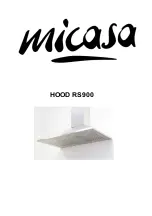
• Always turn the surface burner to OFF before
removing the cookware.
• Always heat fat slowly, and watch as it heats.
• Do not use a wok on models with sealed burners
if the wok has a round metal ring that is placed
over the burner grate to support the wok. This
ring acts as a heat trap, which may damage the
burner grate and burner head. Also, it may cause
the burner to work improperly. This may cause a
carbon monoxide level above that allowed by
current standards, resulting in a health hazard.
• Foods for frying should be as dry as possible.
Frost on frozen foods or moisture on fresh foods
can cause hot fat to bubble up and over sides
of the pan.
• Carefully watch foods being fried at a high
flame setting.
• Use the least possible amount of fat for effective
shallow or deep-fat frying. Filling the pan too
full of fat can cause spillovers when food is added.
• If a combination of oils or fats will be used
in frying, stir together before heating or as fats
melt slowly.
• Use a deep fat thermometer whenever
possible to prevent overheating fat beyond the
smoking point.
• Never clean the cooktop surface when it is
hot. Some cleaners produce noxious fumes and
wet cloths could cause steam burns if used on a
hot surface.
• Be careful when you clean the cooktop because
the area over the pilot (on standing pilot
models) will be hot.
• Never try to move a pan of hot fat, especially a
deep fat fryer. Wait until the fat is cool.
• Use proper pan size—Avoid pans that are unstable
or easily tipped. Select cookware having flat
bottoms large enough to properly contain food and
avoid boilovers and spillovers and large enough to
cover burner grate. This will both save cleaning
time and prevent hazardous accumulations of food,
since heavy spattering or spillovers left on range
can ignite. Use pans with handles that can be easily
grasped and remain cool.
• Do not leave plastic items on the cooktop—
they may melt if left too close to the vent.
• Keep all plastics away from top burners.
• If range is located near a window, do not hang
long curtains that could blow over the top burners
and create a fire hazard.
• Do not leave any items on the cooktop.
The hot air from the vent may ignite flammable
items and will increase pressure in closed
containers, which may cause them to burst.
• To avoid the possibility of a burn, always be
certain that the controls for all burners are at
the OFF position and all grates are cool before
attempting to remove them.
• When flaming foods are under the hood, turn the
fan off. The fan, if operating, may spread the flames.
• When a pilot goes out (on standing pilot models),
you will detect a faint odor of gas as your signal
to relight the pilot. When relighting the pilot,
make sure burner controls are in the OFF position,
and follow instructions in this guide to relight.
• If you smell gas, and you have already made sure
pilots are lit (on standing pilot models), turn off the
gas to the range and call a qualified service
technician. Never use an open flame to locate a leak.
Baking, Broiling and Roasting
• Do not use the oven for a storage area.
Items stored in the oven can ignite.
• Stand away from the range when opening the
door of a hot oven. The hot air and steam that
escapes can cause burns to hands, face and eyes.
• Keep the oven free from grease buildup.
• Place the oven shelves in the desired position
while the oven is cool.
• Pulling out the shelf to the shelf-stop is a
convenience in lifting heavy foods. It is also a
precaution against burns from touching hot
surfaces of the door or oven walls.
• Do not heat unopened food containers.
Pressure could build up and the container
could burst, causing an injury.
• Do not use aluminum foil anywhere in the oven
except as described in this Guide. Misuse could
result in a fire hazard or damage to the range.
(continued next page)
5
Important Safety Instructions






































